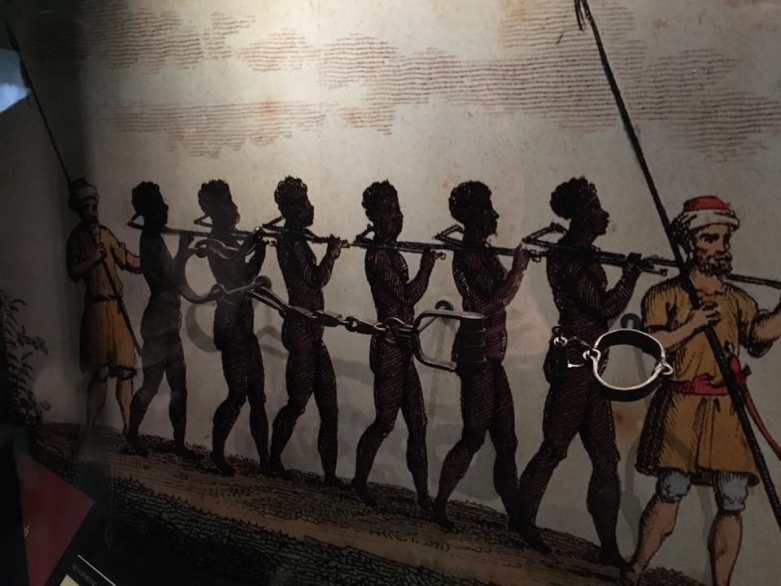Standing on the Shoulders of My Ancestors: My Journey through the National Museum of African American History and Culture
Page Media

On opening day of the Smithsonian’s National Museum of African American History and Culture in Washington, D.C., I crossed the threshold of this impressive edifice with a memory deeply embedded in my psyche.
Many years ago, I visited West Africa for an extended stay and had the opportunity to return to the U.S. on the Black Star Line, the Ghanaian government’s now defunct shipping corporation that operated commercial freighters with a few modest cabins for civilian passengers. We embarked in the port city of Takoradi and made stops in Dakar, Senegal, and Abidjan, Côte d'Ivoire, to load cargo before setting sail across the Atlantic Ocean. Midway through the crossing, we hit rough seas and inclement weather. The rip and roar of the sea and the slapping and clapping of waves against the ship as it heaved through rain and thunder was utterly terrifying. When the storm finally passed and calm seas returned, I went out on deck to survey the horizon. It was then that I had an epiphany that was simultaneously petrifying and inspiring.
Although I was profoundly aware that we were traversing the waters of the Middle Passage, that heinous voyage that transported millions of captive Africans to the Western hemisphere, it was an odd feeling to know that the waters that had threatened the ship hours before and held it afloat now were the same waters that had carried people of the African diaspora packed in the bowels of ships like canned sardines. I viscerally understood how an estimated 2.4 million people could have perished during this dehumanizing crossing, but it was the stark realization that despite all the blood, sweat, and tears shed along the way millions more actually survived. Although centuries removed, I bore witness on that ship to the plight of my people on whose shoulders I stand today and it took my breath away.
It is this daunting and phenomenal story that the museum tells. In this magnificent institution, #APeoplesJourney is depicted beautifully, but often so sorrowfully. Every display, artifact, photo, and written text illuminates how remarkable it was that Africans forcibly brought to the shores of the Americas managed to retain their humanity and had the presence of mind to ultimately endure.
Symbolically, the museum’s subterranean level, the basement, is the chronological beginning of the tour. It’s where I spend the majority of my visit, so dense it is with information and interactivity. In a section called “Slavery & Freedom 1400-1877,” we learn that there was a relatively tiny window of time when Europeans traded with Africans as equal partners. But soon thereafter, profit outweighed parity, and Africans were deemed a more lucrative commodity as slaves, paving the way for the unspeakably horrific trans-Atlantic slave trade. Slaves were licked by their English captors to test for disease, branded for sale at auctions, and children were restrained with dog collars. In 1705, Virginia colonial law stated, “All negro, mulatto, and Indian slaves are considered real estate,” and it was legal to dismember unruly slaves. A display with small shackles made for children’s ankles brings me to tears.
In a scene with huge sculptures, the so-called “Founding Fathers” are flanked at their backs by African-Americans purposefully erected small in stature indicating their lack of agency. Inscribed on an opposite wall are excerpts from the three documents that inform the global perception of the United States: the Declaration of Independence (1776), the U.S. Constitution (1787), and the Bill of Rights (1791). While these iconic documents underscore the aspiration of a new nation, they also expose the hypocrisy of the promise of liberty and justice for all.
Ascending to the next level, I’m transported — as if in a time machine — to “The Era of Segregation, 1877-1968.” Finally liberated from servitude after the Civil War, the scenes show African-Americans thriving in institutions and communities that they created —a period of African-American autonomy not commonly known. More familiar are images from the Jim Crow era that relegated blacks to separate and UNEQUAL status defined by “colored” and “white” signs at public facilities. The rise of the Ku Klux Klan and myriad other forces of oppression are illustrated in glass cases that hold hateful regalia and other artifacts of subjugation. Observing these enormous pressures, I remember Maya Angelou’s famous poem “Still I Rise,” which conveys all the abhorrent yet unsuccessful attempts that have been made to keep black people down.
Looking back, rising became a metaphor for me as I made my way up the levels of the museum. Although each floor depicted a remembrance of pain and struggle, the profound beauty and resilience of African-American people were displayed in increasingly greater measure. I left the National Museum of African American History & Culture with a deeper and fiercer love for my people and enormous pride in all that we’ve overcome and accomplished.
And so, it is quite an irony that soon this glorious museum will be a neighbor to a newly elected president whose own words have indicated that he either has no knowledge of the history housed within its walls or that he’s chosen to disrespect, ignore, or deny it.
But history isn’t stagnant. There will come a time when the past will reveal how African-Americans, in 2017, faced adversity yet again and managed to survive, thrive, and rise.
Candice Francis is the Communications Director for the ACLU of Northern California.
